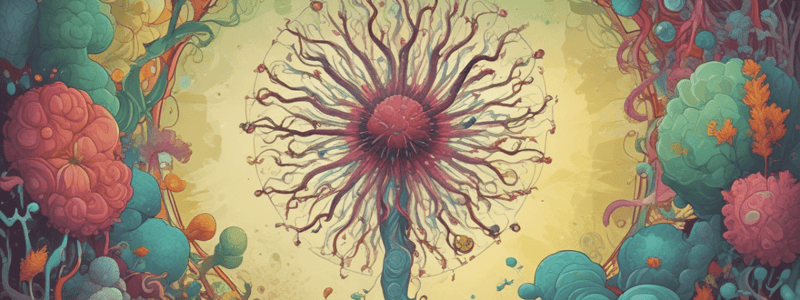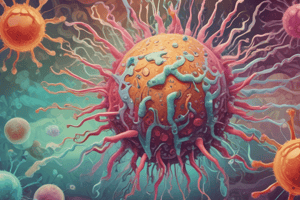Podcast
Questions and Answers
What is the primary site of influenza virus entry into the host?
What is the primary site of influenza virus entry into the host?
- Lymphoid organs
- Lower respiratory tract
- Upper respiratory tract
- Epithelial mucosa (correct)
What is the function of the neuraminidase enzyme on the influenza virus?
What is the function of the neuraminidase enzyme on the influenza virus?
- It cleaves sialic acid sugars on the cell surface (correct)
- It inhibits the immune response
- It facilitates the release of the viral genome
- It binds to sialic acid sugars on the cell surface
What is the primary factor contributing to the rapid evolution of the influenza virus?
What is the primary factor contributing to the rapid evolution of the influenza virus?
- The lack of proof-reading ability in RNA polymerase (correct)
- The high error rate of DNA polymerase
- The presence of multiple serotypes
- The ability of the virus to infect multiple hosts
What is the primary role of the haemagglutinin and neuraminidase proteins on the influenza virus?
What is the primary role of the haemagglutinin and neuraminidase proteins on the influenza virus?
What is the characteristic of the influenza virus genome that contributes to its high mutation rate?
What is the characteristic of the influenza virus genome that contributes to its high mutation rate?
What is the term used to describe the continuous, rapid evolution of the influenza virus?
What is the term used to describe the continuous, rapid evolution of the influenza virus?
What is the outcome of genomic segment reassortment in co-infected cells?
What is the outcome of genomic segment reassortment in co-infected cells?
What is the purpose of detergent treatment in the production of influenza vaccines?
What is the purpose of detergent treatment in the production of influenza vaccines?
Which type of cells are the target cells for papillomavirus?
Which type of cells are the target cells for papillomavirus?
What is the role of the E6 and E7 proteins in HPV infection?
What is the role of the E6 and E7 proteins in HPV infection?
What is the mechanism of action of nucleoside analogues as antiviral drugs?
What is the mechanism of action of nucleoside analogues as antiviral drugs?
What is the advantage of recombinant DNA technology in vaccine production?
What is the advantage of recombinant DNA technology in vaccine production?
What is the target population for HPV vaccination?
What is the target population for HPV vaccination?
What is the purpose of the L1 capsid protein in HPV vaccines?
What is the purpose of the L1 capsid protein in HPV vaccines?
What is the limitation of antiviral treatment for viral infections?
What is the limitation of antiviral treatment for viral infections?
What is the purpose of the quadravalent Gardasil vaccine?
What is the purpose of the quadravalent Gardasil vaccine?
What is the primary mechanism by which Foscarnet prevents HSV replication?
What is the primary mechanism by which Foscarnet prevents HSV replication?
What is the primary component of the HSV 2 vaccine currently in Phase III clinical trials?
What is the primary component of the HSV 2 vaccine currently in Phase III clinical trials?
What is the primary target of HIV reverse transcriptase?
What is the primary target of HIV reverse transcriptase?
What is the primary mechanism by which Protease inhibitors block HIV replication?
What is the primary mechanism by which Protease inhibitors block HIV replication?
What is the primary role of dendritic cells in the initial stages of HIV infection?
What is the primary role of dendritic cells in the initial stages of HIV infection?
What is the primary reason why some HIV-infected individuals appear to be immune to developing AIDS?
What is the primary reason why some HIV-infected individuals appear to be immune to developing AIDS?
What is the primary way that Pleconaril prevents polio virus replication?
What is the primary way that Pleconaril prevents polio virus replication?
What is the effect of Interferons on virus protein production?
What is the effect of Interferons on virus protein production?
What is the primary site of latency for HSV in the body?
What is the primary site of latency for HSV in the body?
What is the primary mechanism of Nucleoside analogue drugs such as Aciclovir?
What is the primary mechanism of Nucleoside analogue drugs such as Aciclovir?
What is the result of excessive use of thymidine analogues in treating HSV infections?
What is the result of excessive use of thymidine analogues in treating HSV infections?
What is the primary route of transmission for HSV?
What is the primary route of transmission for HSV?
What is the effect of reactivation of HSV on the immune system?
What is the effect of reactivation of HSV on the immune system?
What is the role of HSV thymidine kinase enzyme in the activation of Aciclovir?
What is the role of HSV thymidine kinase enzyme in the activation of Aciclovir?
What is the primary reason for the development of newer prodrugs of Nucleoside analogue drugs?
What is the primary reason for the development of newer prodrugs of Nucleoside analogue drugs?
What is the primary effect of HSV infection on the CNS in rare cases?
What is the primary effect of HSV infection on the CNS in rare cases?
Flashcards
Orthomyxoviridae
Orthomyxoviridae
A family of viruses that includes influenza A, B, and C. Types A and B are responsible for seasonal flu outbreaks.
Enveloped
Enveloped
A type of virus that has an outer lipid envelope surrounding its genetic material. Its shape can vary.
ssRNA (-)
ssRNA (-)
Influenza viruses have a single-stranded RNA genome, which is negative-sense, meaning it cannot be directly translated into proteins.
8 segments
8 segments
Signup and view all the flashcards
Types A, B, and C
Types A, B, and C
Signup and view all the flashcards
Host range
Host range
Signup and view all the flashcards
Portal entry
Portal entry
Signup and view all the flashcards
Target cells
Target cells
Signup and view all the flashcards
Symptoms
Symptoms
Signup and view all the flashcards
Pathology
Pathology
Signup and view all the flashcards
Haemagglutinin (HA)
Haemagglutinin (HA)
Signup and view all the flashcards
Neuraminidase (NA)
Neuraminidase (NA)
Signup and view all the flashcards
Antigens
Antigens
Signup and view all the flashcards
Nomenclature
Nomenclature
Signup and view all the flashcards
Influenza virus evolution
Influenza virus evolution
Signup and view all the flashcards
Polymerase enzymes
Polymerase enzymes
Signup and view all the flashcards
RNA mutation rate
RNA mutation rate
Signup and view all the flashcards
Antigenic drift
Antigenic drift
Signup and view all the flashcards
Antigenic shift
Antigenic shift
Signup and view all the flashcards
Vaccine development
Vaccine development
Signup and view all the flashcards
Influenza vaccines
Influenza vaccines
Signup and view all the flashcards
Seasonal influenza
Seasonal influenza
Signup and view all the flashcards
Papillomaviridae
Papillomaviridae
Signup and view all the flashcards
Host range
Host range
Signup and view all the flashcards
Portal entry
Portal entry
Signup and view all the flashcards
Target cells
Target cells
Signup and view all the flashcards
Pathology
Pathology
Signup and view all the flashcards
Oncogenic HPV
Oncogenic HPV
Signup and view all the flashcards
Papillomavirus infection cycle
Papillomavirus infection cycle
Signup and view all the flashcards
L1 protein
L1 protein
Signup and view all the flashcards
HPV and cancer
HPV and cancer
Signup and view all the flashcards
HPV vaccines
HPV vaccines
Signup and view all the flashcards
Study Notes
Influenza Virus
- Family: Orthomyxoviridae
- Enveloped, pleomorphic, ssRNA (-) in 8 segments (1-2kbp)
- Types: A, B, and C (A and B cause epidemics)
- Host range: Specific mammals, but Type A's primary host is birds (natural reservoir in wild aquatic birds)
- Portal entry: Epithelial mucosa via aerosol
- Target cells: Lower respiratory tract
- Symptoms: Cough, fever
- Pathology: Epithelial cells, pneumonia
- Envelope spikes: Haemagglutinin (binds to sialic acid sugars on cell surface) and neuraminidase (enzyme cleaves sialic acid)
- Antigens: Haemagglutinin and neuraminidase for immune response
- Nomenclature based on these glycoproteins (e.g., H5N1 "bird flu" and H1N1 "swine flu")
- H1N1 pandemic in 1918 killed 50 million people
Influenza Virus Evolution
- Polymerase enzymes involved in synthesizing new genomes during replication
- RNA genomes mutate at a faster rate than DNA genomes due to lack of proofreading ability
- Continuous, rapid evolution or "antigenic drift"
- If cell is co-infected, genomic segment reassortment can produce new virus subtype ("antigenic shift") with altered virulence and tropism
- Frequent emergence of new subtypes makes effective vaccine production difficult
Influenza Virus Vaccines
- Mostly dead vaccines are employed, where several current isolates are detergent-treated to release H and N proteins ("Split Virion")
- Used for seasonal influenza in "at-risk" individuals (adults, particularly 65+ and 50+ years old)
Papillomavirus
- Family: Papillomaviridae
- DNA genome
- Host range: Specific types infect birds, mammals (humans, 60 types)
- Portal entry/target cells: Small wounds in skin (keratinocytes) or mucosa via direct contact
- Pathology: Benign tumors (warts), cervical cancer
- Specific types infect specific sites and are oncogenic (cancer-causing)
- Acute infection → latency
- Later reactivation (e.g., when immunocompromised) produces local blisters (virus shedding)
- Envelope spikes: L1 capsid protein binds to surface of cell
- HPV and Cancer: E6 and E7 inactivate cell's tumor suppressor proteins, promoting cell growth → benign/premalignant tumors
- HPV types 16 and 18 cause 70% of cervical (+ anal) cancer cases
- HPV types 6 and 11 cause 90% of genital wart cases
- HPV vaccines: Bivalent CERVARIX (GSK) and quadravalent GARDASIL (Merck)
Anticancer Vaccine
- Consists of genetically engineered, purified L1 capsid protein that forms virus-like particles (VLPs)
- Aim to vaccinate pre-pubescent girls before exposure to HPV
Recombinant Vaccine
- Molecular biology techniques enable production of genetically engineered/recombinant DNA vaccines
- Example: Hepatitis B surface antigen (1st recombinant vaccine)
- Involves cloning the viral gene into a suitable DNA expression vector, transferring the clone into an appropriate cell line, and purifying the expressed protein
Antiviral Drugs
- Three main problems for antiviral treatment:
- When clinical symptoms appear, virus replication has peaked – too late for therapy
- Difficult to discriminate between virus multiplication and cell processes
- Selection of resistant mutants
- Most antivirals only target replicating (not latent) viruses
- Nucleoside analogues mimic bases in DNA, activated by virus, stopping virus DNA synthesis and thus propagation
- Inhibitors of attachment, release
- Resistance/Other Treatment: Foscarnet (AstraZeneca) is a pyrophosphate analogue that binds to HSV DNA polymerase, preventing DNA synthesis
Varicella Zoster Virus
- VZV – chicken pox and shingles
- VZV is a herpes, not a pox virus
- Shingles vaccine (prophylactic): Zostavax (Sanofi), contains live attenuated virus
Studying That Suits You
Use AI to generate personalized quizzes and flashcards to suit your learning preferences.




